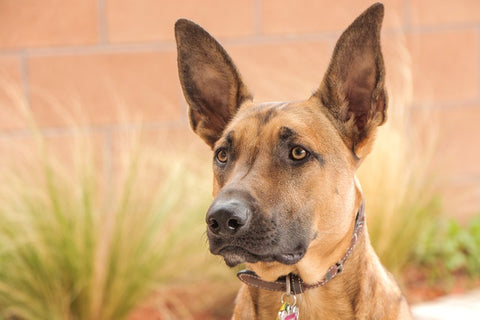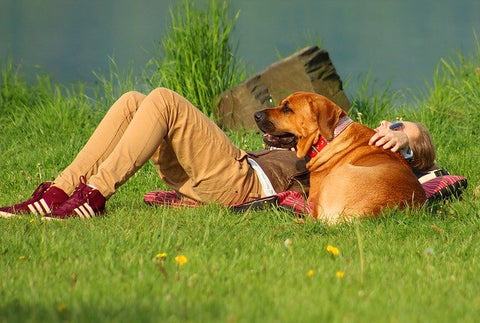Dogs are bilingual, but just can't talk in the human ways, their expressions and wagging tail give some tell-tale signs of their feeling.
The communication are two ways, since a human has no wagging tail, our man’s best friend must look elsewhere for signs as to how their master feels.
01. Shocking Look
Sometime, the dog will feel the fear too by the extreme shocking look, here is the video that you seldom see.
02. Reluctant Look
The dog is just like humans, will show the annoying and reluctant look when they are unwilling, but have to obey to the master instruction. Watch the video.

03. Ears Up and Down
Ears back while they lick your face, to show that they mean you no harm.
Flat ears are typically submissive, but it could also be in fear if they’re pinned back tightly.
Ears up or forward means that your dog is aware and alert, they may want to play or they might be looking for a few extra strokes.
Ears at a relaxed, neutral position means the dog is at ease, such as when they’re resting.

04. Eyebrow-raising
When your dog raises one eyebrow or both while making eye contact, it’s a sign of alertness and interest.

05. That Soulful Gaze
Dogs have acquired this understanding and use their gaze to win approval from and show love for their humans.

06. Breaking Eye Contact
Dogs stare at each other until one or the other breaks the gaze—and a fight could break out.
With humans, dogs are perfectly comfortable breaking eye contact, and in no way is it a prelude to trouble. Rather, it indicates a comfortable rapport between a dog and his person.

07. Blinking or Squinting during Eye Contact
If a dog blink while making eye contact with you, he may be contemplating what you’re thinking, especially when you have just given a command.
The same is true of squinting during eye contact, it is a sign of appeasement, with his human.

08. Avoiding Eye Contact
A dog that avoids eye contact with humans is doing his best to avoid any kind of interaction, whether negative or positive. Sometimes, we see this in the dogs that have recently been rescued from bad situations.

09. Whale Eye
‘Whale eye’ is a term used to specifically describe when the whites of a dog’s eyes are clearly visible. The sclera can sometimes appear normally, but it’ll often be mixed with other signs of agitation or focus on certain target.

10. Hard Stare
A ‘hard stare’ can be tough to deal with, especially if you are not confident around dogs in the first place. Also known as ‘hard eye’, the fixed stare is different to whale eye, but the meaning is the same. The dog isn’t happy with what they’re looking at.

11. Head Tilting
Head tilting is a gesture used to convey curiosity or listening to you.

12. Head Lowering
When your dog head bows or lowers his head while gazing up at you, it is an act of submission.

13. Nose Wrinkling
When your dog pulls his lips up vertically to display his front teeth while also wrinkling his muzzle, he’s angry—especially when he raises his ears up and stares steadily, there’s a good chance a growl is coming.

14. Tightly Closed Mouth and Long Lip
You will have to be careful if you spot a dog with a tightly closed mouth. It’s generally a warning sign for most animals, and they’re likely to feel tense at the very least.

15. Grimacing
When your dog draws his lips back horizontally so that you can see all his teeth, it indicates discomfort or fear and may accompanied by ear-flattening.

16. Yawning
A yawn could indicate tiredness and it can also be associated with moments of stress.

17. Lip-licking
A dog who is licking his lips can be communicating a desire to submit to his human, it could indicate anxiety, depending on the context.

18. Guilty Look
Most owners will be able to recognise that typical ‘guilty look’ on the face of their dog after they’ve done something wrong.

19. Smiling or Grinning
Yes, dogs do smile, when a dog lifts up his lips to show his canine teeth and incisors, it’s a sign of excitement, dogs tend to smile while out on walks or romping with pals at the dog park.

20. Wag their Tails
A fast, full-circle wag that gets your dog’s entire backside involved is a clear sign he’s overjoyed to see you. But other tail wags can indicate hesitation, agitation, or even dog hostility. Depending on the circumstances, slow wags and stiff wags may indicate your dog is feeling anxious or he’s on the offensive.

21. Playful
A playful dog is happy and joyful. The ears are up, the eyes are bright, and the tail usually wags rapidly. The dog may jump and run around with glee. Often, a playful dog will exhibit the play bow: front legs stretched forward, head straight ahead, and rear end up in the air and possibly wiggling. This is most certainly an invitation to play.

22. Share their Toys with You
If your dog drops his favourite toys at your feet, bounds around, and looks at you expectantly, he’s telling you he wants to play. But when he drops his toys near you and walks off for a rest in his bed, this action should warm your heart, as your dog is sharing his treasures with you—his favourite person.

23. Leans on You
When you’re sitting on the couch and your dog leans his body weight against your legs, he’s showing his affection, by pressing his weight against you reassures him as he rests or takes a nap and this is more common in large dog breeds.

24. Snuggle with Your Dirty Laundry
If you have to check your dog’s bed or crate for missing dirty socks and T-shirts every laundry day, take it for the compliment it is. Your dog knows your smell and finds comfort in it when you’re out of sight. For a dog with separation anxiety, it may be helpful to consciously place a few items of unwashed clothes near him when you leave him home alone.

Here has a very touching real story, the Muslim Farmer and his dog of 12 years, after the farmer passed away, the dog Amin also passed away a few days later by snuggling the farmer's shirt.


Comments
Post a Comment